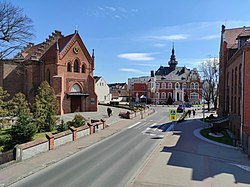Opalenica
Opalenica | |
|---|---|
 Town center | |
| Coordinates: 52°18′28″N 16°24′49″E / 52.30778°N 16.41361°E | |
| Country | |
| Voivodeship | Greater Poland |
| County | Nowy Tomyśl |
| Gmina | Opalenica |
| Area | |
• Total | 6.42 km2 (2.48 sq mi) |
| Population (2006) | |
• Total | 9,104 |
| • Density | 1,400/km2 (3,700/sq mi) |
| Time zone | UTC+1 (CET) |
| • Summer (DST) | UTC+2 (CEST) |
| Postal code | 64-330 |
| Vehicle registration | PNT |
Opalenica [ɔpalɛˈɲit͡sa] is a town in Nowy Tomyśl County, Greater Poland Voivodeship, Poland, with 9,861 inhabitants (as of 2007).
History
The Opaliński noble family originated here as lords of the area and a branch of the Bniński family of Łodzia coat of arms. Opalenica was granted town rights in 1400.[1] Opalenica was a private town, administratively located in the Kościan County in the Poznań Voivodeship in the Greater Poland Province of the Kingdom of Poland.[2]
During the German occupation of Poland (World War II), the first expulsions of 183 Poles were carried out in December 1939.[3] The Poles were sent to a transit camp in Młyniewo, and afterwards deported to the General Government in the more-eastern part of German-occupied Poland, while their houses, workshops, etc. were handed over to German colonists as part of the Lebensraum policy.[3] The Polish resistance was active in Opalenica. Heliodor Jankiewicz, commander of the local unit of the Narodowa Organizacja Bojowa organization, was arrested by the Germans in 1941, and then sentenced to death and executed the following year.[4] In 1943, the occupiers renamed the town to Oppenbach in attempt to erase traces of Polish origin. In January 1945, a German-perpetrated death march of prisoners of various nationalities from the dissolved camp in Żabikowo to the Sachsenhausen concentration camp passed through the town.[5]
There was a narrow-gauge railway in Opalenica, but it closed and was then dismantled to make way for the A2 motorway.
The Portugal National Football Team was based here during the European Championships of 2012 held in Poland and Ukraine.[6]
Gallery
- Saint Joseph church
- Saint Matthew church
References
- ^ Łuczak, Czesław (1993). Dzieje Opalenicy. Poznań: ABOS. ISBN 83-85811-03-6.
- ^ Atlas historyczny Polski. Wielkopolska w drugiej połowie XVI wieku. Część I. Mapy, plany (in Polish). Warszawa: Instytut Historii Polskiej Akademii Nauk. 2017. p. 1a.
- ^ a b Wardzyńska, Maria (2017). Wysiedlenia ludności polskiej z okupowanych ziem polskich włączonych do III Rzeszy w latach 1939-1945 (in Polish). Warszawa: IPN. p. 156. ISBN 978-83-8098-174-4.
- ^ Encyklopedia konspiracji Wielkopolskiej 1939–1945 (in Polish). Poznań: Instytut Zachodni. 1998. p. 227. ISBN 83-85003-97-5.
- ^ "Ewakuacja piesza". Muzeum Martyrologiczne w Żabikowie (in Polish). Retrieved 27 November 2023.
- ^ "Gdzie mieszkają piłkarze na Euro 2012? Portugalia w Opalenicy, Dania w Kołobrzegu" (in Polish). Retrieved 20 April 2023.





